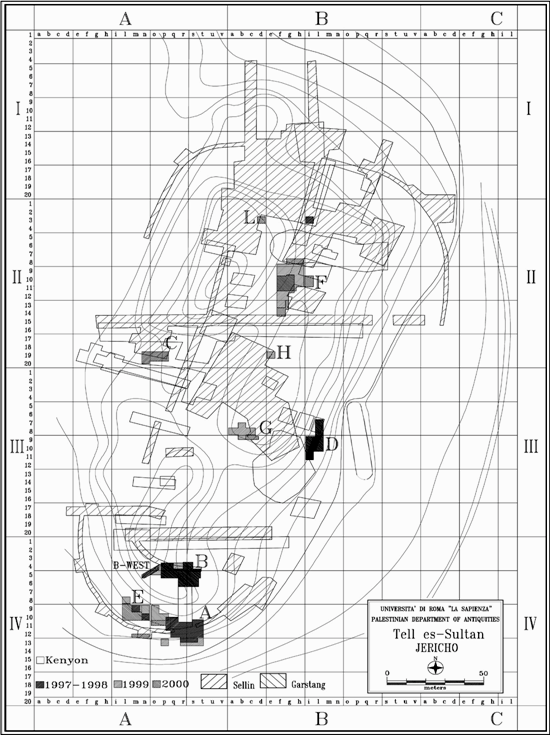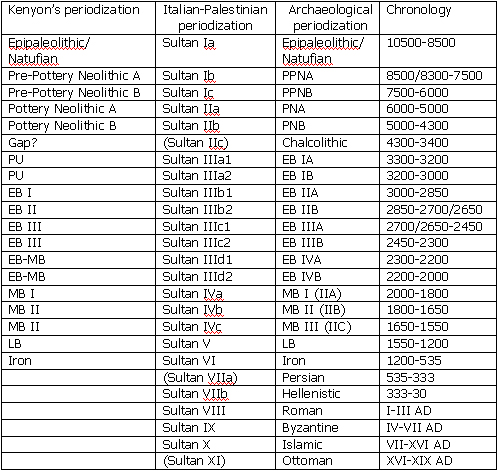1. Introduction
 In 1997, the main
goals of the Italian-Palestinian Expedition at Tell es-Sultan/ancient Jericho
were, of course, resuming archaeological
excavations at such an important site,
at the crossroads of many cultural areas and different environments, which has
provided one of the most complete chronological sequence in pre-classical
Palestine, but also starting a pilot project of cooperation between the
Palestinian Department of Antiquities and Cultural Heritage, and Rome
�La Sapienza� University, which
foresaw the training of young Italian and Palestinian archaeologists. The main
focus of the Expedition during the four campaigns (1997-2000) was the
investigation of the urban plan, stratigraphy and culture of the Bronze Age city
(Sultan III-IV), also re-evaluating data collected by previous Austro-German and
British Expeditions.
In 1997, the main
goals of the Italian-Palestinian Expedition at Tell es-Sultan/ancient Jericho
were, of course, resuming archaeological
excavations at such an important site,
at the crossroads of many cultural areas and different environments, which has
provided one of the most complete chronological sequence in pre-classical
Palestine, but also starting a pilot project of cooperation between the
Palestinian Department of Antiquities and Cultural Heritage, and Rome
�La Sapienza� University, which
foresaw the training of young Italian and Palestinian archaeologists. The main
focus of the Expedition during the four campaigns (1997-2000) was the
investigation of the urban plan, stratigraphy and culture of the Bronze Age city
(Sultan III-IV), also re-evaluating data collected by previous Austro-German and
British Expeditions.
This
task was accomplished opening nine excavation areas, with interesting results
concerning the site topography and extension, the development of its
fortification system, and the stratigraphic sequence, which has also allowed a
reappraisal of finds of previous expeditions.
The fourth and
last season of excavations of the Italian-Palestinian Expedition at Tell es-Sultan/Jericho
took place in September-October 2000; unluckily, it was interrupted due to the
severe political situation. Nevertheless, since then, the study of the results,
stratigraphy and finds, produced by the Italian-Palestinian Expedition has
continued, updating the archaeological knowledge of the history of the site.
The following
summary presents the excavations results in stratigraphic and chronological
order, following the most recent periodization, where the Early Bronze Age is
represented by the four phases of Sultan IIIa-d, covering a period which lasted
from the last third of the IV millennium BC till the end of the III millennium
BC, and the Middle Bronze Age is represented by the three phases of Sultan IVa-c,
from the beginning to the middle of the II millennium BC.

 In 1997, the main
goals of the Italian-Palestinian Expedition at Tell es-Sultan/ancient Jericho
were, of course, resuming archaeological
excavations at such an important site,
at the crossroads of many cultural areas and different environments, which has
provided one of the most complete chronological sequence in pre-classical
Palestine, but also starting a pilot project of cooperation between the
Palestinian Department of Antiquities and Cultural Heritage, and Rome
�La Sapienza� University, which
foresaw the training of young Italian and Palestinian archaeologists. The main
focus of the Expedition during the four campaigns (1997-2000) was the
investigation of the urban plan, stratigraphy and culture of the Bronze Age city
(Sultan III-IV), also re-evaluating data collected by previous Austro-German and
British Expeditions.
In 1997, the main
goals of the Italian-Palestinian Expedition at Tell es-Sultan/ancient Jericho
were, of course, resuming archaeological
excavations at such an important site,
at the crossroads of many cultural areas and different environments, which has
provided one of the most complete chronological sequence in pre-classical
Palestine, but also starting a pilot project of cooperation between the
Palestinian Department of Antiquities and Cultural Heritage, and Rome
�La Sapienza� University, which
foresaw the training of young Italian and Palestinian archaeologists. The main
focus of the Expedition during the four campaigns (1997-2000) was the
investigation of the urban plan, stratigraphy and culture of the Bronze Age city
(Sultan III-IV), also re-evaluating data collected by previous Austro-German and
British Expeditions.